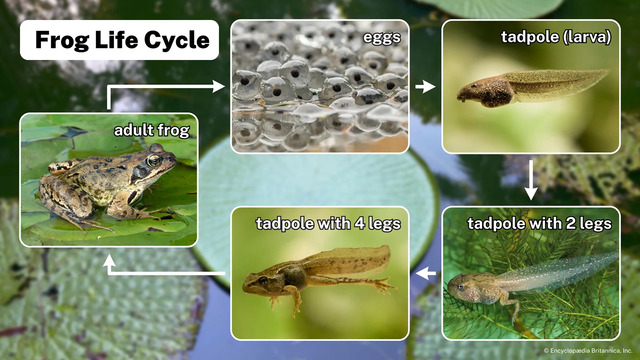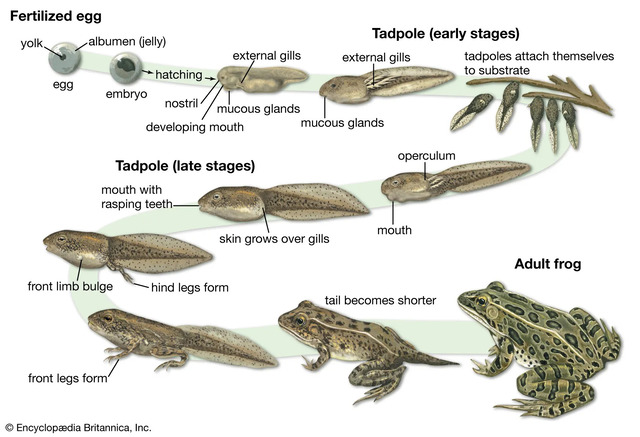tadpole or polliwog (also spelled pollywog) ,Frogs belong to the amphibian class (Amphibia), meaning they can live both in water and on land. Their life cycle is a classic example of biological metamorphosis, in which they undergo a dramatic transformation from aquatic larvae (tadpoles) to terrestrial adults (frogs). This process is a key feature of amphibian evolution and demonstrates how organisms adapt to different environments.
Understanding how tadpoles turn into frogs is essential not only for biology enthusiasts but also for conservationists, as frogs play a crucial role in maintaining ecological balance by controlling insect populations and serving as indicators of environmental health.
Egg Stage: Frog eggs are laid in water, forming clusters known as frogspawn.
Tadpole Stage: Hatchlings are fully aquatic, breathing through gills and feeding on algae.
Froglet Stage: Legs develop, lungs form, and the body prepares for a terrestrial lifestyle.
Adult Frog Stage: The tail disappears, and the frog becomes a fully developed terrestrial or semi-aquatic amphibian.

Frogs reproduce through external fertilization, where the female lays eggs in water, and the male fertilizes them externally.
A single female can lay hundreds to thousands of eggs in a gelatinous mass to protect them from predators and environmental changes.
The incubation period varies by species and environmental conditions but usually lasts 7 to 10 days.
During this period, the embryo develops into a tadpole inside the egg before hatching.
Tadpoles resemble small fish, with a rounded head, elongated tail, and no limbs.
They have gills for breathing and lack lungs at this stage.
They swim using their tails, making them efficient in water.
Tadpoles rely on external gills for oxygen intake from water.
As they grow, their gills become internal, and later, lungs start developing in preparation for a terrestrial life.
In the early stages, tadpoles are herbivores, primarily feeding on algae and aquatic plants.
As they grow, some species become omnivorous, consuming small insects and microorganisms.
Over 4 to 6 weeks, tadpoles increase in size, developing more defined body structures.
This stage is crucial as they store energy for the upcoming metamorphosis.
The froglet stage is when the most dramatic transformations occur, signaling the shift from aquatic to semi-terrestrial life.
The hind legs appear first, emerging as small buds before fully forming.
Front legs develop later, giving the tadpole the ability to hop and move on land.
The tadpole’s tail begins to shrink, as it is gradually absorbed into the body to provide nutrients for continued development.
By this stage, lungs become fully functional, allowing the froglet to breathe air.
Tadpoles start surfacing occasionally to gulp air, signaling their adaptation to terrestrial breathing.
The dietary habits shift from plant-based to protein-rich diets, including small insects, larvae, and other invertebrates.
This adaptation prepares the frog for its predatory lifestyle.
The tail completely disappears, marking the final stage of metamorphosis.
The frog’s body structure is now optimized for jumping, with strong hind legs and a flexible spine.
Frogs fully transition to lung breathing, making them capable of surviving on land.
Depending on the species, adult frogs may be terrestrial, aquatic, or arboreal (tree-dwelling).
They become carnivorous, preying on insects, spiders, and small animals.

Water temperature: Warmer temperatures accelerate growth, while cold environments slow development.
Oxygen levels: Proper oxygenation ensures healthy gill function before lung development.
Pollution and habitat destruction: Chemicals, pesticides, and habitat loss can increase mortality rates.
Tadpoles face threats from fish, birds, and aquatic insects.
To counteract high predation rates, frogs lay thousands of eggs to ensure species survival.
Frogs help control insect populations, reducing the spread of diseases like malaria.
Since frogs absorb pollutants through their skin, their presence (or decline) serves as a warning sign of ecosystem changes.
Tadpoles contribute to water filtration by consuming algae and organic matter, promoting a balanced aquatic environment.
Urbanization, deforestation, and wetland drainage reduce breeding areas.
Chemical runoff from pesticides disrupts frog reproduction.
Rising temperatures affect tadpole development rates.
Protecting wetlands and freshwater sources is essential for amphibian survival.
Captive breeding programs help restore endangered frog populations.
Reducing pesticide use benefits both frogs and their ecosystems.
The transformation of tadpoles into frogs is one of nature’s most astonishing biological processes. From tiny, fish-like larvae to agile, land-dwelling amphibians, frogs showcase an incredible evolutionary adaptation that allows them to thrive in diverse habitats.
Understanding this metamorphosis not only deepens our appreciation of amphibians but also highlights the importance of conserving their habitats for future generations.
Wells, K. D. (2007). The Ecology and Behavior of Amphibians. University of Chicago Press.
Duellman, W. E., & Trueb, L. (1994). Biology of Amphibians. Johns Hopkins University Press.
Global Amphibian Assessment, IUCN Red List.
animal tags:
We created this article in conjunction with AI technology, then made sure it was fact-checked and edited by a Animals Top editor.